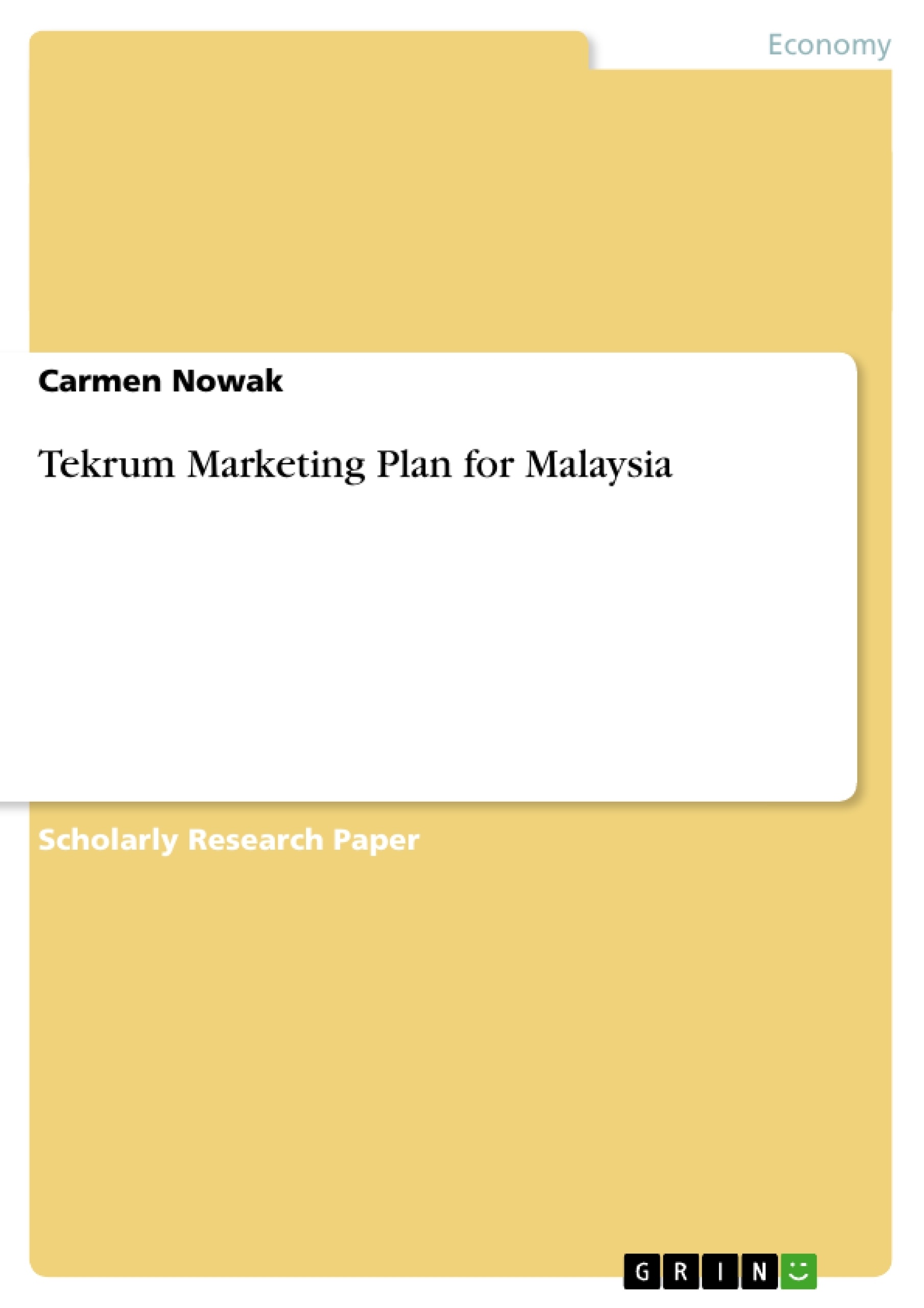I. Content
II. List of Tables
III. List of Figures
IV. List of Abbreviation
1. Introduction & Mission Statement
1.1. Introduction
1.2. Mission Statement
2. Current Market Position (Internal Audit)
2.1. Product
2.2. Place
2.3. Price
2.4. Promotion
3. Market Overview (External Audit)
3.1. General Market Overview
3.2. Information about Malaysia
3.3. Asia-Pacific Market Value
3.4. Asia-Pacific Market Volume
3.5. Market Segmentation
3.6. Market Share
3.7. Competitors in Malaysia
3.8. Distribution
3.9. Market Value Forecast
3.10. Market Volume Forecast
3.11. Flavour Preference Asia
3.12. Western Products & Quality Products in Malaysia
3.13. PESTEL-Analysis of Malaysian Market
3.14. Porter’s Five Forces of the Malay’ Biscuit Market
4. SWOT Analysis
4.1. Strengths and Weaknesses of Tekrum
4.2. Threats and Opportunities of Tekrum
4.3. SWOT-Analysis of Tekrum
4.4. Key Issues and Opportunities for Tekrum
4.5. SWOT Analysis of Kraft Foods
4.6. SWOT Analysis of Munchy’s
5. Assumptions
6. Marketing Objectives
7. Strategy
7.1. Brief description of Strategy
7.2. Target Markets
7.3. Positioning Statement
7.4. Branding Strategy
7.5. Product strategy
7.6. Pricing strategy
7.7. Place Strategy
7.8. Promotional Strategy
8. Estimated Costs Year 1
9. Control & Evaluation
V. Bibliography
VI. Appendix
Inhaltsverzeichnis (Table of Contents)
- Introduction & Mission Statement
- Introduction
- Mission Statement
- Current Market Position (Internal Audit)
- Product
- Place
- Price
- Promotion
- Market Overview (External Audit)
- General Market Overview
- Information about Malaysia
- Asia-Pacific Market Value
- Asia-Pacific Market Volume
- Market Segmentation
- Market Share
- Competitors in Malaysia
- Distribution
- Market Value Forecast
- Market Volume Forecast
- Flavour Preference Asia
- Western Products & Quality Products in Malaysia
- PESTEL-Analysis of Malaysian Market
- Porter's Five Forces of the Malay' Biscuit Market
- SWOT Analysis
- Strengths and Weaknesses of Tekrum
- Threats and Opportunities of Tekrum
- SWOT-Analysis of Tekrum
- Key Issues and Opportunities for Tekrum
- SWOT Analysis of Kraft Foods
- SWOT Analysis of Munchy's
- Assumptions
- Marketing Objectives
- Strategy
- Brief description of Strategy
- Target Markets
- Positioning Statement
- Branding Strategy
- Product strategy
- Pricing strategy
- Place Strategy
- Promotional Strategy
- Estimated Costs Year 1
- Control & Evaluation
Zielsetzung und Themenschwerpunkte (Objectives and Key Themes)
This marketing plan aims to establish a comprehensive strategic framework for Tekrum High-Class Pastry to successfully penetrate the Malaysian market. It provides a detailed analysis of the current market landscape, identifies key opportunities and challenges, and outlines a strategic approach to achieve sustainable growth. The key themes explored within this document include:- Market analysis: A comprehensive overview of the Malaysian market, including its characteristics, consumer preferences, and competitive landscape.
- SWOT analysis: Identifying strengths, weaknesses, opportunities, and threats for Tekrum in the Malaysian market to guide strategic decision-making.
- Marketing strategies: Developing a strategic framework encompassing product positioning, pricing, distribution, and promotional strategies tailored for the Malaysian market.
- Cost estimation: Providing a preliminary cost estimate for the first year of operation to guide resource allocation and financial planning.
- Control and evaluation: Establishing a framework for monitoring the implementation and effectiveness of the marketing plan, ensuring ongoing adaptation and optimization.
Zusammenfassung der Kapitel (Chapter Summaries)
The marketing plan begins with an introduction to Tekrum High-Class Pastry, outlining its mission and core values. It then delves into the current market position of Tekrum by conducting an internal audit, examining factors such as its product offerings, distribution channels, pricing strategies, and promotional efforts. This chapter provides a foundational understanding of Tekrum's strengths, weaknesses, and current market presence.
The next section presents a comprehensive external market analysis, providing insights into the general market overview of the Malaysian market, focusing on the confectionery industry specifically. It examines market trends, consumer preferences, and key competitors, including their market share and strategies. This chapter provides a detailed picture of the opportunities and challenges Tekrum faces in the Malaysian market.
The marketing plan further explores the key factors influencing Tekrum's success by conducting a SWOT analysis. This section identifies the company's strengths and weaknesses, along with opportunities and threats, to guide strategic decision-making. The SWOT analysis identifies critical areas for focus, potential risks, and potential strategic advantages.
Following the SWOT analysis, the marketing plan outlines the proposed strategy for Tekrum's entry into the Malaysian market. This chapter includes defining target market segments, developing a clear brand positioning statement, and outlining strategies for product offerings, pricing, distribution, and promotion. It lays out a comprehensive framework for achieving Tekrum's marketing objectives in the Malaysian market.
The final section of the preview focuses on the estimated costs for the first year of Tekrum's operations in Malaysia. It also details a framework for control and evaluation, outlining methods for monitoring the implementation and effectiveness of the marketing plan. This section provides a clear understanding of the financial considerations involved and emphasizes the importance of continuous evaluation and adaptation to ensure success.
Schlüsselwörter (Keywords)
The marketing plan revolves around key terms and concepts related to market analysis, strategic planning, and successful market penetration. These keywords include:- High-class pastry
- Malaysian market
- SWOT analysis
- Marketing strategies
- Target markets
- Branding
- Pricing
- Distribution
- Promotion
- Cost estimation
- Control and evaluation
- Arbeit zitieren
- Carmen Nowak (Autor:in), 2009, Tekrum Marketing Plan for Malaysia, München, GRIN Verlag, https://www.grin.com/document/147988



